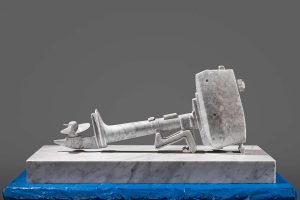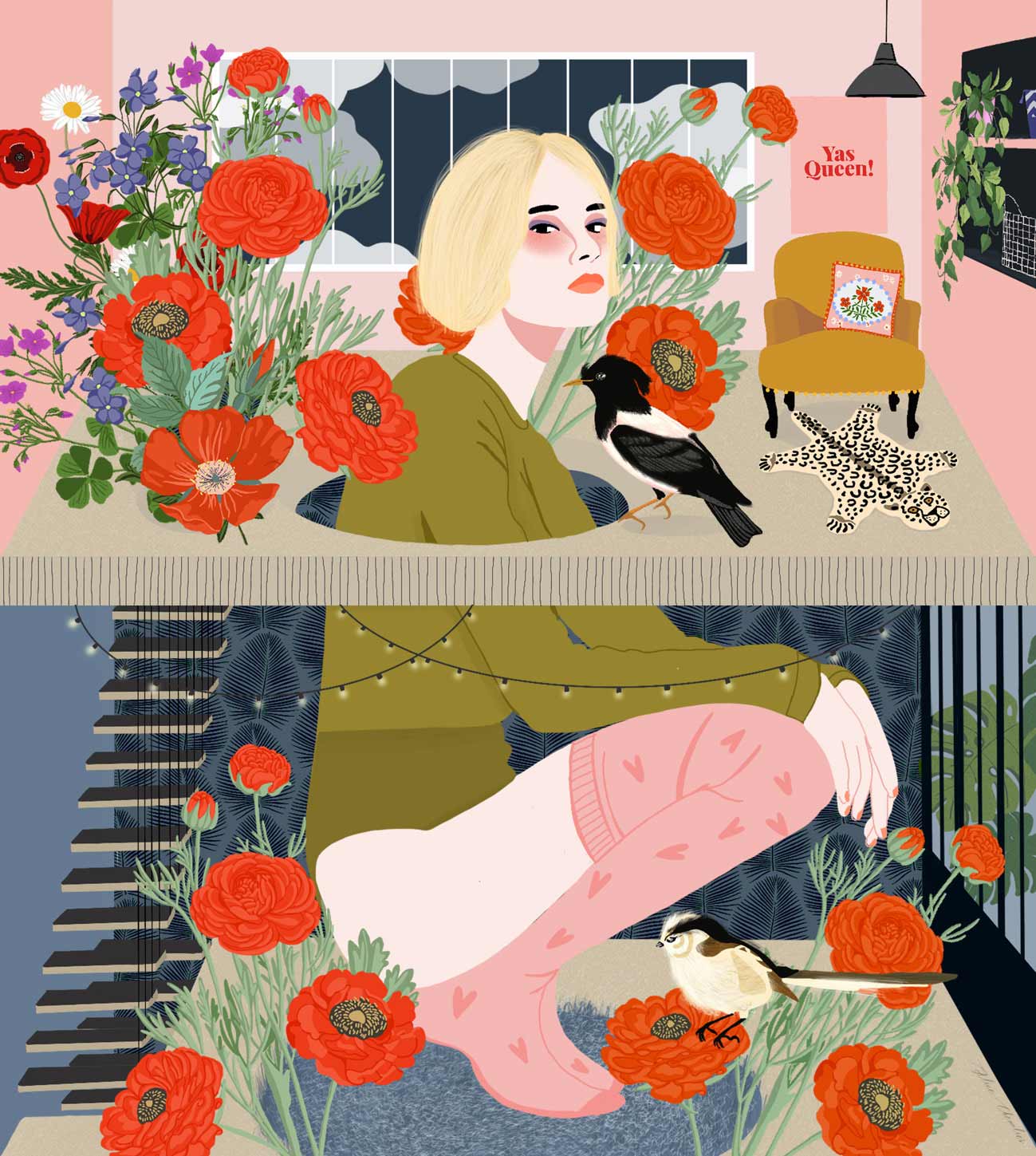Working in education, teaching students at university level is a very honourable thing, but my art was unfulfilled. I was captivated by this void, something was missing in my life, and I felt like I was wearing something that didn’t fit.
Interior architect turned self-taught artist, La Aeng, left the safe confines of her university career in Korea for the stark other-ness of life in Berlin, in search for identity and meaning. In a conversation with Sonalee Tomar, she talks about finding unknown versions of herself in the new culture, and returning to Korea to express them in the layered textures of her urban landscapes.

A memory of the city, 2019
Take us to the beginning of your journey. How did your tryst with art begin?
I completed my Bachelors in Home Management, and a Masters in Interior architecture and started teaching in 2000. I taught subjects related to interiors and architecture until 2013. Working in education, teaching students at university level is a very honourable thing, but my art was unfulfilled. I was captivated by this void, something was missing in my life, and I felt like I was wearing something that didn’t fit. I lived a monotonous life with these thoughts for a long time, and then I left for Berlin to change my life. I chose Berlin just because my friend was living there, but life there was not comfortable. Five months later, I returned to Korea.
The short five-month spent in Berlin made me think of the social relationships that I experience in Korea. I met new and unknown versions of myself in the new culture. I was wondering about my existence, who I am, what I want now, what I want to do, and why I am here. Even after coming back, I continue to ask these questions.
When I quit my job, I bought a pen and a small sketchbook and started drawing. I drew what I saw. I walked around the streets and alleys of the city. I drew houses and urban landscapes, and I sat in a café and drew people. I committed to a 365day drawing project where I made a drawing every day. The drawings then lead to painting urban landscapes on old books. I learned to draw by watching artists from all over the world on the internet, and going to exhibitions. And I did my first solo exhibition in January this year.

Details, A memory of the city, 2019
What inspires you?
The place where I am staying is an old town. This is an urban landscape that still retains memories of the past, but they are fast disappearing. Old houses textured with traces of time, corroded walls, abandoned buildings. These are quickly being demolished and replaced by new structures that are devoid of history or identity. In some places the newly built things are mixing with the old existing things. It looks attractive but I feel a vague sense of sadness for their disappearance. These things and the city’s landscapes inspire me. I’m inspired by nature too. Nature is mysterious and amazing. It’s like a new novel that we can enjoy every day for free.

Details, A memory of the city, 2019
Take us through your process.
I usually draw or work where I am staying, when I travel. I walk around the alleys and streets of the city. When I meet a cityscape that appeals to my heart, I stop walking, and draw on the spot. Sometimes I take pictures and work in the studio. I like to express the momentary feelings and various emotions that I sense in the field and nature.
My drawings are made with watercolour, pen and Chinese ink. My paintings are urban landscapes painted on old discoloured books. I like to collage over these, with discarded paper boxes, leaflets, and stickers of advertisements on the walls. I think these materials – old discoloured books, torn and discarded paper boxes, single-use leaflets, and old and corroded advertising stickers resemble an old city that is disappearing over time. It is similar to the flow of the lives of city dwellers who live in intertwined structures.

La’s studio
Which exhibitions, performances and experiences have shaped and altered your own perspective?
I went to museums and exhibitions in Berlin. At that time, I was just longing for art. I was surprised by the diversity and quantity of art while I toured exhibitions, envious that I could easily see famous works that are hard to come by in Korea. I saw an old building that was occupied by artists and used as art studios and they had painted on the walls. I was so impressed by the artists who expressed art in that space without forgetting its identity. Living in Berlin for five months has taught me a lot. While walking through the streets, I saw Berliners who weren’t gorgeous, but charming, a bit rough but natural, not decorated but unique and special. And I looked back at myself through their eyes.
All artists are maestros to me. From famous artists to young new ones. I see, feel, and learn many things from them.

Setting up the show, A memory of the city, 2019
What are the biggest challenges in your work? What has been your biggest learning experience?
Every moment of my work is a challenge. I did not major in art. I’m self-taught, learning art in the process of working. And I learn life in the process. Repeated attempts and challenges, a quiet and lonely work that teaches me about who I am and my existence, my identity and what life is.

A memory of the city, 2019
What trends have you observed in the world?
Today the boundaries between the genres of contemporary art seem to blur. Art, craft, design and architecture are all mixed up. The art of convoluted visual emphasis, and the art of large and splendid installations seems to be attracting attention.
How do you foresee art evolving?
AI (Artificial Intelligence) is challenging the realm of painting. I think the field of AI is going to expand more. Advances in new visual elements with digital art and 3D printing will be developed more actively. Art in Korea is still regarded as a luxury enjoyed by people with money. Art for the general public is a difficult thing, an unfamiliar area. However there is an attempt to get art out of the art gallery, allowing art to permeate everyday life, such as at a shopping mart. There are many attempts in Korea to make it easier to buy the artists’ works, an art market in the streets, exhibitions in empty houses and empty shopping malls, cafes, online sales and shows. These attempts will continue. Just as the genre of rock has developed into K-Pop, I think K-Art will become common in Korea and the world.

Setting up the show, A memory of the city, 2019
How do you balance life and art?
Realistically, a balance between life and art is not easy. Without my family’s help, I would not have been able to do the work until now. I sometimes work part-time or make and sell art products. I walk for about an hour a day and try to empty my thoughts. This time is very important to me. It is an extension of my creative process.
Way forward. What’s coming next?
I plan to proceed further with the series ‘A memory of the city’ that I’m working on currently. I’d like to express a larger and more complex urban landscape. I’d like to expand the scope of the various city landscapes by drawing and painting. This work will probably be my second solo exhibition. And I’m going to make a book or art products with the drawings that I’ve previously worked on.
What is the primary role of an artist in society?
I think the role of artists in society is to insert sensitivity into a repetitive everyday life, which I think leads us to live a more prosperous life. Artists question existence, relationships and the various problems and phenomena that occur in society. I think artists play the role of starting a dialogue to make people think about these things.












Add Comment